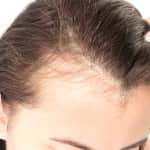
Thinning Hair? The Best Supplements to Help Regain Your Hairline
Supplements
Hair loss is an all-too-common issue for both men and women. Healthcare experts routinely see patients concerned about hair loss but, in many instances, those patients can take steps to minimize or halt additional hair loss. However, that's not always true, which means everyone should understand a few hair loss basics.

Thinning Hair? The Best Supplements to Help Regain Your Hairline
Supplements
Hair loss is an all-too-common issue for both men and women. Healthcare experts routinely see patients concerned about hair loss but, in many instances, those patients can take steps to minimize or halt additional hair loss. However, that's not always true, which means everyone should understand a few hair loss basics.
Start With the Basics
The Mayo Clinic reports that alopecia, or hair loss, can affect all parts of a person's body and can be either temporary or permanent.1 It's important to understand that while males experience baldness more than women, anyone can experience hair loss, so it isn't uncommon for younger people and women to go through some form of hair loss.
Mayo's article goes on to explain that, in most cases, baldness involves losing a high percentage of your hair from the scalp area. Hereditary baldness, also referred to as male pattern baldness or androgenic baldness, is the most common hair loss type. However, that doesn't mean men should simply give up any thought of stopping their hair loss.
It's also vitally important to remember that not all hair loss has anything to do with genetics. In many instances, men experience hair loss due to illnesses, infections, or the use of harsh chemicals. Even a person's diet impacts hair health, so it's always a good idea to work with your healthcare team to determine the underlying causes of any hair loss.
Obviously, when genetics is involved, there is little the medical profession can do to prevent some level of hair loss. However, there are strategies anyone can use to minimize their hair loss or even regrow some hair.
Women also experience hair loss, but not as many people are familiar with the term female pattern baldness. In the majority of cases, women don't lose as much of their hair as men with hereditary hair loss, the issue often creates self-confidence issues in women who experience hair loss.2
Many women have watched their mothers, aunts, or even older siblings experience some degree of hair loss. If that's the case, most experts recommend taking steps to minimize any hair loss before any loss occurs. There are numerous strategies women can take to reduce the amount of hair they lose.
Hair Loss Symptoms
The symptoms of hair loss are similar in both men and women, so there are several circumstances to pay attention to. Here are a few of those symptoms.
- Gradual Thinning. In most instances, hair loss is gradual rather than sudden. A person may notice a few more strands have been lost after shampooing. In men, a receding hairline is common, as is a gradual loss of hair at the rear of the head. Women typically notice a wider part line during the onset of hair loss. Some older women may also experience a receding hairline.
- Losing a Lot of Hair Suddenly. In many cases, a traumatic event will trigger the sudden loss of a great deal of hair. Large patches of hair may come loose, leaving obvious bald spots. This type of hair loss is generally temporary, but it may trigger a permanent hair loss cycle.
- Scaly patches on the Scalp. In most instances, scaly patches are a sign of ringworm rather than a permanent form of hair loss. It's important to schedule an appointment with a physician to evaluate the condition and provide the proper care.
- Patchy Bald Areas. Alopecia areata is a common autoimmune disease that affects people of both genders and can happen at any age.3 Because the severity of the condition will vary dramatically from one patient to the next, it's important to work with a healthcare professional that's treated the condition in the past.
- Full Hair Loss. As a rule, full-body hair loss only occurs when specific medical conditions are present. A patient may lose all body hair at once, especially after events like chemotherapy. Again, this type of hair loss is generally temporary.
If you're familiar with the various types of hair loss, it's easier to work with experts to explore ways to regrow lost hair or minimize any additional losses. Treating hair loss can be easy or complicated, depending on the specific issues present.
Treating Hair Loss or Thinning Hair
Fine, wispy hair is common with people experiencing hair loss, but that type of hair can be treated to appear fuller and less delicate. Most experts agree there a few steps people with thin or wispy hair can take to make their hair look and feel nicer.
According to Function of Beauty, one of the most important things a person with thin or wispy hair should consider is adjusting the type and amounts of shampoo and conditioner they use.4 Thin hair tends to look greasy shortly after shampooing. That can be remedied by selecting a shampoo and conditioner specifically formatted for thin, wispy hair.
Next, the same article recommends avoiding oil-based hair care products. Instead, opt for choices like dry shampoos, volumizing mousse, sea salt spray, and texturizing mists. Those products get away from that heavy, oily look and leave hair looking fuller.
The third hint from the article is to minimize the amount of hair care products used. In other words, use far less of those products than you may have been accustomed to using in the past. With a little experimentation, you'll quickly learn how much of each product is needed to make your hair look its best.
The fourth hint is to use a wide-tooth comb instead of a brush after washing your hair. Thin hair is easy to break off, and using a comb results in less pulling and breakage. After your hair is dry, it's okay to use a soft brush, but be careful.
The final tip is to keep your hair trimmed. Don't put off a visit to your stylist, as split ends are common with thin or wispy hair. Longer hair styles will also be harder to manage.
Vitamins, Supplements, and Other Strategies
It's also important to remember that diet and exercise play roles in the health of your hair. If you're starting to lose hair, talk to a dietician to determine what types of supplements may be beneficial. Use every strategy available to keep your hair looking its best for as long as possible.
Biotin and Niacin (also known as vitamin B3) are also recommended when people suffer hair loss. In many instances, minerals like zinc, sulfur, selenium, and iron are missing from a person's diet. Taking supplements helps to restore the body's natural balance of vitamins and minerals and may help to restore a person's hair.
1 Hair Loss, Mayo Clinic. https://www.mayoclinic.org/diseases-conditions/hair-loss/symptoms-causes/syc-20372926
2 Women and Hair Loss: Possible Causes, WebMD. https://www.webmd.com/skin-problems-and-treatments/hair-loss/women-hair-loss-causes#1
3 What you need to know about alopecia areata, National Alopecia Areata Foundation. https://www.naaf.org/alopecia-areata
4 The Ultimate Guide to Caring for Fine Hair, Function of Beauty. https://www.functionofbeauty.com/blog/new/how-to-care-for-fine-hair/

Jay Todtenbier is an original founder of SupplementRelief.com in 2010 and has operated the business ever since. He is also a tennis instructor and gospel musician. Formerly he spent 25 years in business development, technology and marketing with startups and major corporations having gone through the tech boom in Silicon Valley in the 90s. He became passionate about, and began studying and practicing Wellness as a Lifestyle after experiencing chronic, personal health challenges including depression, auto-immune disorders, and being overweight that impacted his ability to live a healthy, vibrant life. Since then, he has been an advocate for healthier living encouraging others to live better through making small, gradual changes to lifestyle behaviors relating to whole-foods nutrition, stress management, reasonable exercise, proper sleep, and the use of targeted, high-quality supplements.
Learn more about Jay Todtenbier.
-
 Discussion Forum
Questions or Feedback?
Discussion Forum
Questions or Feedback?Ask questions. Share your thoughts. Note that we cannot answer questions relating to specific medical conditions - please refer those to your qualified healthcare provider.
Post a new Comment or Reply to an existing one. Help for using the Discussion Forum.
 Discussion Forum Help
Discussion Forum Help
Comments are displayed in order of the last one posted so the most recent one is at the top and the oldest one at the bottom.
Replies within a Comment are displayed in reverse order with the oldest one at the top and the most recent one at the bottom.
Each post identifies
 who made the post and the
who made the post and the  date and time the post was made.
date and time the post was made.Mouse over the icons for tooltips that explain what they mean.

If you see this icon you can attach an Audio file to your post.

If you see this icon you can attach a Document file to your post.

If you see this icon you can attach an Image file to your post.

If you see this icon you can attach a Video file to your post.
You will see the
 Ban icon (Report Post as SPAM) immediately following the Timestamp of the post. Click this icon if you feel strongly that the content posted is not appropriate and should be reviewed by the Forum Moderator. You will be provided with a confirmation dialog to be sure you wish to submit this post for review. If submitted, the Forum Moderator will be notified to review the post and will determine what type of action to take.
Ban icon (Report Post as SPAM) immediately following the Timestamp of the post. Click this icon if you feel strongly that the content posted is not appropriate and should be reviewed by the Forum Moderator. You will be provided with a confirmation dialog to be sure you wish to submit this post for review. If submitted, the Forum Moderator will be notified to review the post and will determine what type of action to take.Click
 in the upper right corner of this Help modal or anywhere on the web page outside of the modal to exit Help.
in the upper right corner of this Help modal or anywhere on the web page outside of the modal to exit Help.
![]() Session Expired from Inactivity
Session Expired from Inactivity
Do you want to?
9618 Jefferson Highway, Suite D-191
Baton Rouge LA 70809-9636
(888) 424-0032 |
support@supplementrelief.com
* Disclaimer: This page is available exclusively for SupplementRelief.com clients. None of the information on this website is intended to replace your relationship with your healthcare provider(s). Nothing should be considered medical advice. The information, knowledge, and experience shared on this website are the opinions of SupplementRelief.com. This site and its content are intended to enhance your knowledge base as YOU MAKE YOUR OWN HEALTHCARE DECISIONS in partnership with your qualified health professional.
* These statements have not been evaluated by the Food and Drug Administration. These products and services are not intended to diagnose, treat, cure, or prevent disease.
* There is NO GUARANTEE OF SPECIFIC RESULTS for the products or services offered, and the RESULTS CAN VARY for each individual. Any results claimed by our customers are based on individual experiences that are unique and cannot be guaranteed.
FirstFitness Nutrition and NuMedica may be promoted and sold on the internet ONLY by Authorized Resellers who have been approved by and have registered their website domain with these companies. They strictly prohibit, and actively monitor, the UNAUTHORIZED SALE or RESALE of their products in ALL online public shopping portals including Amazon, eBay, and others and into other countries. All products purchased in SupplementRelief.com are for PERSONAL USE ONLY and CANNOT BE RESOLD to others. Please report violations of Reseller Policy directly to FirstFitness Nutrition at 800.621.4348 and to NuMedica at 800.869.8100.
The content and photographs on this website are copyrighted or Licensed Material and may not be downloaded for other than personal use. Republication, retransmission, reproduction, or any other use of the content or photographs is prohibited. ©2010-2024 SupplementRelief.com.
Are you sure you want to remove this item?

